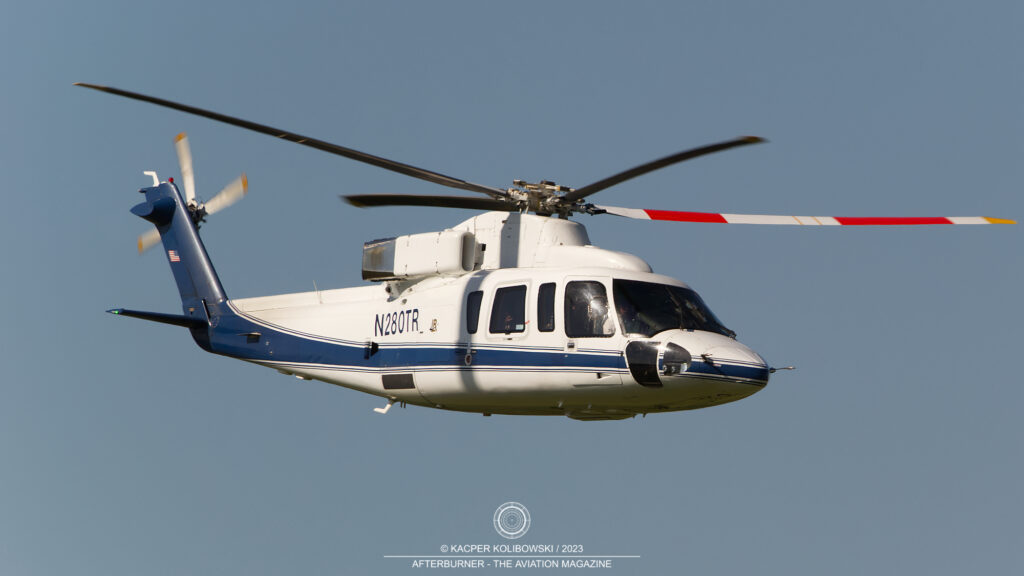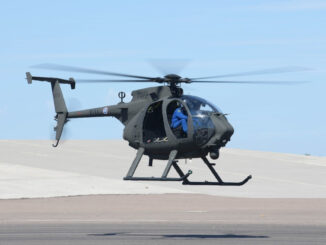 Sikorsky S-76B (c/n 760344, N280TR), dynamic performance at the 2023 World Helicopter Rally, Płock, August 2023.
Sikorsky S-76B (c/n 760344, N280TR), dynamic performance at the 2023 World Helicopter Rally, Płock, August 2023.
Development of the S-76 helicopter, began in the mid-1970s and, initially, the rotorcraft was known as S-74. However, over time, its designation was changed to S-76 to honour the US Bicentennial – a series of celebrations of historical events which lead to creation of the United States as an independent republic.
Although its design included technology of rotor heads and blades from S-70 rotorcraft (aka UH-60 Black Hawk), the S-76 was the first helicopter developed by the Sikorsky company intended entirely to meet the needs of the civilian and commercial markets. The initial concept was to create a medium-sized rotorcraft suitable for corporate transport (six-passenger VIP variant), as well as to be used by oil drilling industry (twelve-passenger version) for transporting workers to the offshore rigs.
The first flight of the S-76 prototype took place on 13th March 1977. Shortly after, on 21st November 1978, the rotorcraft received its initial type certificate from the US Federal Aviation Administration (FAA).
On 27th February 1979, the first example of the helicopter was delivered to its owner – Air Logistics from New Iberia, Louisiana. In the end of 1978, the S-76 received its official name ‘Spirit’. However, yet on 9th October 1980, the name was dropped by the manufacturer, reportedly due to problems with its translation in some foreign languages.
The first production version of the helicopter was designated S-76A. Then, in 1982, S-76 Mk II was introduced into the market. It was a development of the S-76A, equipped with more powerful engines and incorporating a few other improvements.
In 1987, another version, this time designated S-76B, entered into production. Being alternatively powered by two types of engines – PT6B-36A and PT6B-36B by Pratt & Whitney Canada – the S-76B could reach the speed of 287 kph (177.3 mph) at sea level.
In the early 2000s, next variant of the helicopter, S-76C+, was developed and soon became the main serial-produced version. The S-76C+ was powered with yet another type of engines – two Turbomeca Arriel 2S1 with Full Authority Digital Engine Control (FADEC) – and was also equipped with Honeywell Electronic Flight Instrument System (EFIS) suite. Additionally, the rotorcraft had active noise suppression, vibration dampers and main rotor blades made of composite.
On 3rd January 2006, manufacturing of another version, known as S-76C++, began. Besides being powered with twin Turbomeca Arriel 2S2, the new variant of the helicopter featured improved and more quiet transmission, as well as incorporated a few minor interior equipment and avionics improvements.
Work on the next version, the S-76D, was affected by four years of delay, caused by technical problems with expanding the flight envelope. Eventually, the prototype of the D variant made its maiden flight on 7th February 2009. Although the FAA certification for this version was not received until 12th October 2012.
The S-76D was powered by new, different type of engine – a pair of the P&W Canada PW210S, each generating of 1050 hp. Similarly to the C+ version, the D variant was equipped with composite rotor blades, enhanced with an active anti-vibration system.
In the 2010s, production of the S-76 helicopters significantly decreased. Between 2016 and 2020, only twelve examples of the rotorcraft were delivered to customers. Nevertheless, in September of 2013, a Chinese company Changhe Aircraft Industries signed a memorandum of understanding with Sikorsky to manufacture S-76D helicopter cabins for the American based company. .
In March of 2022, Sikorsky halted new orders for the S-76 and, at the same time, the company began with assessing potential foreign production partners and the possibility of licensing helicopter production in other countries. Among the reasons there were decreasing sales number, the high cost of supplying and producing the helicopters, as well as excessive cost of adapting the S-76 to constantly increasing safety requirements.
Eventually, after three remaining orders were completed, production of the S-76 helicopters was ceased in April of 2022. Until that time, Sikorsky had produced just over 875 examples of the rotorcraft belonging to the S-76 family. Nowadays, the company is still manufacturing spare parts for this type of helicopters, at its facility in Connecticut, USA.
Over the years, a total of twelve variants and sub-variants of the S-76 helicopter have been developed, including two military rotorcraft – AUH-76 ‘Dragon Lady’ (an armed utility transport version of the S-76 Mk II) and H-76 Eagle (a militarised version of S-76B, suitable for naval operations).In 1982, the S-76A set as many as twelve aviation world records for speed, range and time of climb in its weight class, reaching the maximum speed of 345.7 kph (214.8 mph) at a closed course of 500 kilometres (311 miles). In June of 1995, an Australian entrepreneur and pilot Dick Smith, flew the S-76 around the world from East to West. This makes the helicopter the first ever to fly around the world in this direction.
As it was expected from the beginning, the S-76 gained popularity as a helicopter for offshore operations. Through the years of service, that rotorcraft family was also operated by various airlines from all over the world, including Helijet Airways from Vancouver, British Columbia, Canada; Flexjet headquartered in Cleveland, Ohio; or LR Airlines from Ostrava, the Czech Republic.
The VIP version of the helicopter received no less attention. For example, in 2005, during campaign for the UK general election, both Labour and Conservative Party members used S-76 helicopters to travel quickly around the United Kingom. According to Jason Lambert, vice president of commercial and military systems at the Sikorsky company, the S-76 proved particularly popular with VIP customers. Until 2020, as stated by the manufacturer, ten countries were operating the S-76s for the head of state transport duties.
The S-76 helicopters were also occasionally used to test new technologies and capabilities. The highly modified S-76 Sikorsky Helicopter Advance Demonstrator of Operators Workload (SHADOW) rotorcraft was built to demonstrate an advanced cockpit for single-pilot operations and to investigate the human engineering interface between the pilot and the cockpit controls and displays. That development was later instrumental in the RAH-66 Comanche armed reconnaissance helicopter programme.
In 2010, the S-76 was for the first time configured for autonomous operation. Six years later, the rotorcraft flew a distance of approximately 48 kilometres (30 miles) without human intervention beyond limited input via a tablet. The take-off and landing phases were also performed autonomously.
Nevertheless, the second decade of the 21st century was marked by withdrawing the majority of the S-76 helicopters from active service. Several operators replaced the Sikorsky family with latest medium helicopters, such as AgustaWestland AW139. In addition, by the early 2020, the S-76D had become non-compliant with FAA regulations and therefore not allowed to be sold to any US customer (although sales to other countries were still possible). And finally, as already mentioned above, production of the helicopter came to a definitive end within two years.
The S-76 helicopter pictured within our Photo of the Week series represents the B variant of the rotorcraft. The aircraft is being operated by LR Airlines from the Czech Republic and being based at Ostrava-Mošnov airfield.
In August of 2023, the helicopter participated in the World Helicopter Rally held at Płock airfield in Poland, where this photo was taken.



